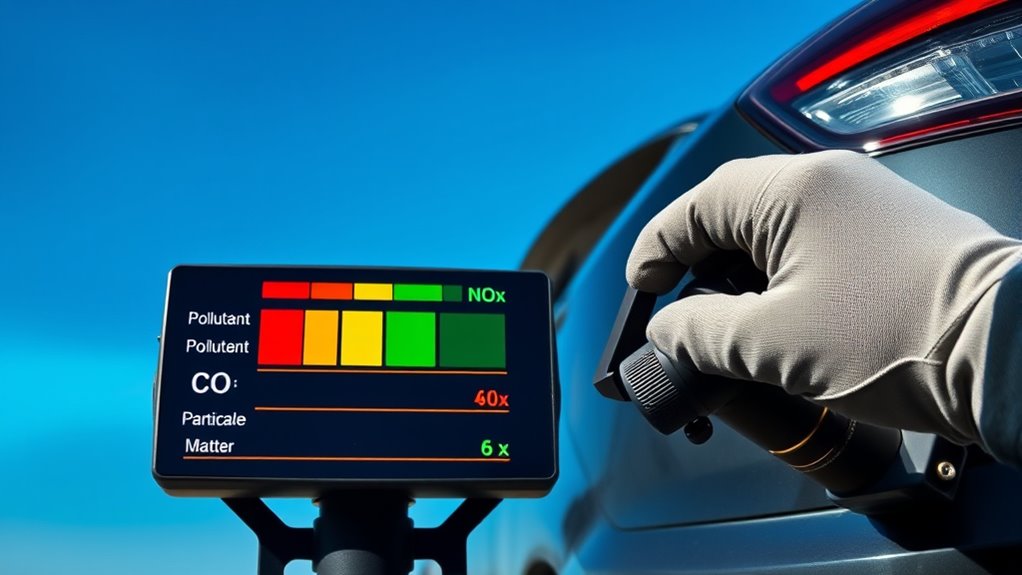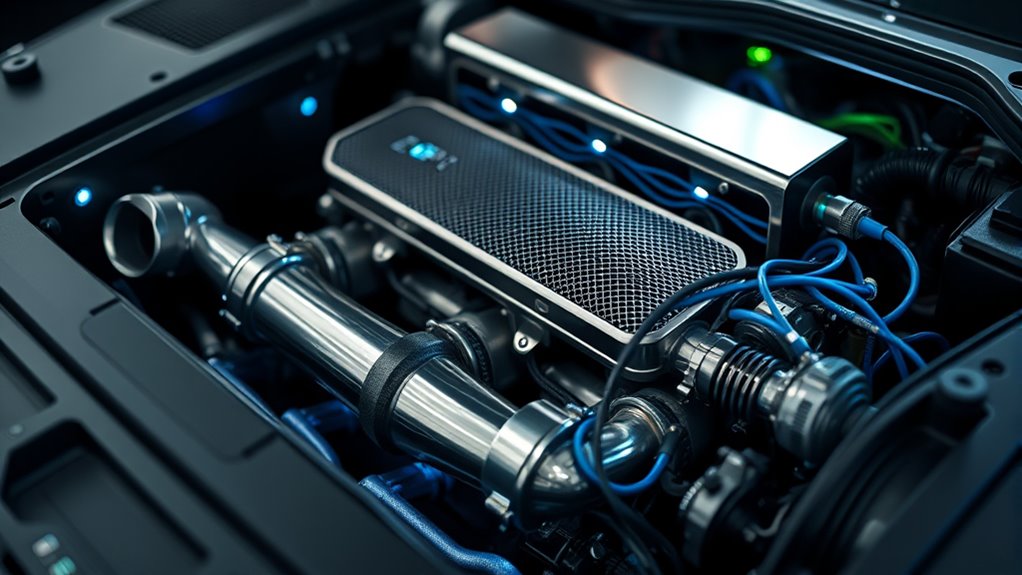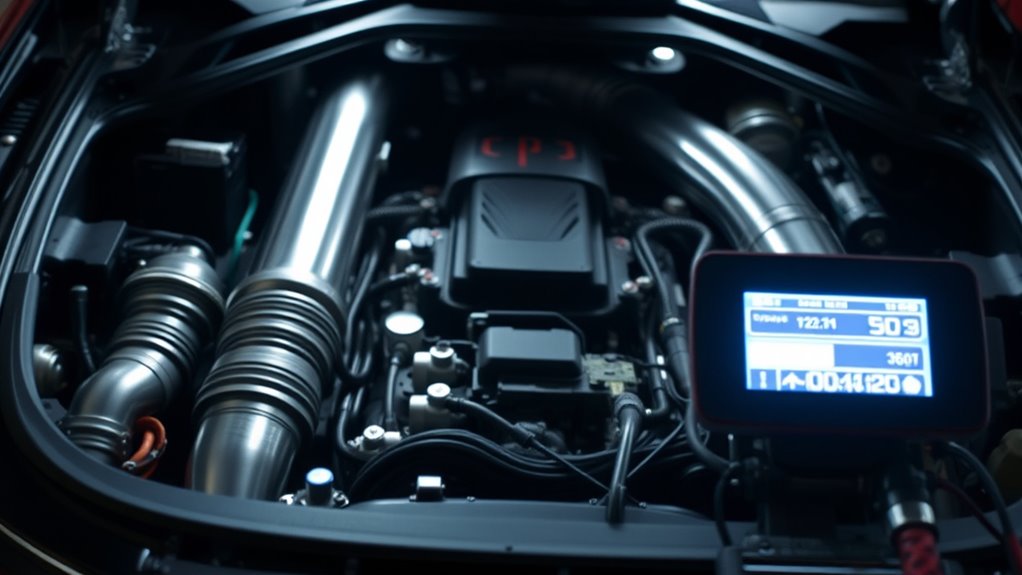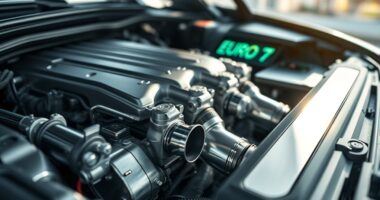Understanding emissions standards and tuning is vital, as strict regulations target pollutants like CO2, NOx, and PM, affecting vehicle performance and legal compliance. Over the decades, laws have become more demanding, pushing automakers to adopt cleaner technologies such as catalytic converters and advanced filters. Tuning or modifying emission systems illegally can lead to hefty fines, damage, and environmental harm. Staying informed helps you navigate these rules and discover how future standards could impact your vehicle’s operation.
Key Takeaways
- Tuning and modifying emission systems illegally can lead to hefty fines, warranty voidance, and compliance issues.
- Emission standards regulate pollutants like CO2, NOx, SO2, and PM, with evolving limits to combat environmental and health impacts.
- Technologies such as catalytic converters, SCR systems, and cleaner fuels help vehicles meet emissions regulations.
- Tampering with emission controls is illegal and contributes to increased air pollution, harming public health.
- Future standards aim for significant reductions globally, promoting electric vehicles and stricter industry compliance.
Understanding Key Pollutants and Their Limits

Have you ever wondered which pollutants in vehicle emissions pose the biggest health and environmental risks? You should know that carbon dioxide (CO2) is a major contributor to climate change, trapping heat and warming the planet. Reducing CO2 emissions is essential for combating global warming. Carbon monoxide (CO), a toxic gas from incomplete combustion, reduces oxygen in your blood, affecting your health. Nitrogen oxides (NOx) create smog and irritate your lungs, especially on hot days. Sulfur dioxide (SO2) forms acids that cause acid rain and corrode engines. Particulate matter (PM), mainly from diesel engines, can lodge deep into your lungs, causing respiratory problems. These pollutants also emit toxic chemicals like benzene and formaldehyde, linked to cancer. Understanding these limits helps you grasp the importance of emission controls for cleaner air and a healthier environment. Emission standards play a crucial role in regulating these pollutants to protect public health and the environment. Additionally, pollutant regulation helps improve air quality standards and encourages the development of cleaner vehicle technologies.
Evolution of Emission Regulations Over the Decades

Over the decades, emission regulations have evolved considerably as governments and agencies have recognized the urgent need to address air pollution and protect public health. Early efforts in the 1940s and 1950s, like California’s pioneering rules, laid the groundwork. The 1960s and 1970s saw landmark laws, such as the Clean Air Act of 1970, which mandated a 90% reduction in vehicle emissions and led to the creation of the EPA. Regulations expanded in the 1980s and 1990s, targeting industrial sources and diesel engines, while the late 1990s marked the start of greenhouse gas controls. Today, regulations continue to tighten, pushing automakers toward cleaner technologies. The importance of emission testing ensures compliance and effectiveness of these standards. Continuous advancements in regulatory frameworks demonstrate the ongoing commitment to improving air quality and reducing environmental impact.
Technologies Behind Emissions Control and Compliance

Technologies behind emissions control and compliance are essential tools that help industries and automakers meet increasingly strict environmental standards. You’ll find EPA models, like those developed by Sargent & Lundy, evaluating options such as fuel switching, dispatch adjustments, and unit retirement to control pollutants like SO2, NOx, and Hg.
Catalysts, filters, and adsorbers work together to drastically reduce emissions, especially in vehicle exhaust systems. Technologies like catalytic converters and diesel particulate filters (DPFs) convert pollutants into harmless substances, while SCR systems target NOx reduction. These systems are designed to operate within integrated frameworks to optimize emission reductions. Incorporating emissions control technologies can significantly improve environmental performance and ensure regulatory compliance.
For industrial emissions, scrubbers like LSFO remove sulfur dioxide. Hybrid systems combine multiple technologies for enhanced performance. The deployment of advanced emission control systems is crucial for meeting evolving environmental standards and reducing the impact of pollutants.
These tools, combined with operational strategies and cleaner fuels, enable compliance with evolving standards and promote cleaner energy transitions.
Challenges and Risks of Tuning and Modifying Emission Systems

Modifying or tuning emission systems might seem like an easy way to boost vehicle performance or fuel economy, but it carries significant legal, health, and operational risks. Since the 1970s, tampering with emission controls has been illegal under federal law and can lead to severe penalties. Legally, you risk hefty fines—up to $45,268 per vehicle—and shop liabilities exceeding $46,192 per violation. Your vehicle’s warranty could be voided, and you might lose insurance coverage, plus face registration bans for tampering. Health-wise, tampered vehicles emit more NOx and particulate matter, worsening air quality and increasing risks like asthma, heart attacks, or premature death. Operationally, noncompliance can damage your reputation, lead to costly recalls, and invite federal or state investigation. Many tampering practices—like deleting filters or installing defeat devices—are illegal and contribute to environmental harm, which can also impact community health.
Future Directions in Vehicle Emissions Standards

As governments around the world implement increasingly strict emissions standards, the automotive industry is accelerating its shift toward cleaner vehicles. Globally, regulations like the EU’s 45% reduction target for heavy-duty vehicles by 2030 and the US EPA’s new standards for 2027 aim to cut harmful emissions markedly. The EPA’s recent standards update has been approved by the Biden administration to help automakers meet these ambitious goals, providing additional flexibility and time for EV manufacturing and adoption. Countries such as Canada and the UK plan to make zero-emission vehicles (ZEVs) the norm, targeting 100% ZEV sales by 2035. Technological advancements, including electrification and innovative vehicle designs, support these goals. Investment in electric vehicle production is booming, creating jobs and boosting industry growth. These stricter standards not only reduce pollutants and combat climate change but also promote global cooperation, fostering a future where cleaner, more efficient transportation becomes the standard worldwide. Emphasizing vehicle emissions standards encourages automakers to innovate and adopt sustainable practices at an accelerated pace, aligning with international environmental commitments to achieve global climate targets.
Frequently Asked Questions
How Do Aftermarket Parts Affect Vehicle Emissions Compliance?
You might wonder how aftermarket parts impact your vehicle’s emissions compliance. If you install parts that alter engine airflow, fuel delivery, or emissions controls without proper certification, you risk violating laws.
Some aftermarket parts are approved, like replacement or CARB-certified EO parts, but others, such as defeat devices, can increase pollution and are illegal.
To stay compliant, verify your aftermarket parts meet federal and state standards and avoid tampering with emissions controls.
Can Tuning Improve Fuel Economy Without Violating Standards?
You might think tuning’s just about more power, but surprisingly, it can boost your fuel economy too—without breaking any rules.
By carefully adjusting the air-fuel ratio and optimizing fuel injection, you keep emissions in check while saving gas. It’s a balancing act, but with smart tuning, you get better mileage and stay compliant.
Who knew that improving efficiency could be so clever and legal at the same time?
What Are the Penalties for Illegal Emissions Modifications?
You should know that illegal emissions modifications carry serious penalties. If you’re caught tampering, you could face fines up to $4,819 per violation as an individual or up to $48,192 per violation as a business.
Repeated offenses can lead to fines exceeding a million dollars. The EPA is cracking down on these violations, and penalties can include civil fines, criminal charges, and even daily fines of $37,500.
Are Electric Vehicles Subject to Similar Emissions Regulations?
While electric vehicles have zero tailpipe emissions, they still face emissions regulations, unlike traditional vehicles. You might think they’re exempt, but regulations focus on the overall environmental impact, including electricity generation.
These standards encourage automakers to improve EV technology and promote cleaner energy sources. By complying, you help reduce greenhouse gases, making EVs a crucial part of the effort to meet stricter emissions goals and protect the environment.
How Does Real-World Driving Testing Impact Emissions Standards Enforcement?
Real-world driving testing directly impacts emissions standards enforcement by ensuring vehicles meet set limits outside laboratory conditions. You see, using Portable Emissions Measuring Systems, authorities collect data across various driving scenarios, revealing actual emissions.
This helps identify noncompliant vehicles, enforce regulations, and push manufacturers toward cleaner technologies. As a result, real-world testing tightens compliance, reduces discrepancies, and promotes transparency.
Ultimately, these efforts lead to cleaner air and more accurate standards enforcement.
Conclusion
As you navigate the road ahead, imagine your vehicle as a steady breath of clean air, guided by evolving standards and cutting-edge tech. Staying compliant keeps your engine’s pulse healthy and the air around you clearer. Embrace responsible tuning, like fine-tuning a musical instrument, ensuring harmony between performance and environmental health. By understanding and respecting these standards, you help paint a brighter, cleaner horizon for everyone’s journey.










